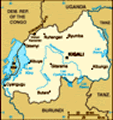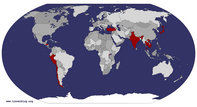Advertisement
Published: August 1st 2013
It’s not often that you can live out one of your childhood dreams. When I was a child, I loved the movie “Gorillas in the Mist: The Dian Fossey Story.” The film details the story of an American scientist who goes to Rwanda to live among the gorillas. Her conservation efforts are credited with being the major contributor to the gorillas’ preservation today. In the movie, Dian Fossey gets close to the gorillas. She sits, crossed legged, on the ground face to face with the gorillas. She mimics them. She shares their world. As a child, I dreamed that I too would come that close to the gorilla. The appeal was magnetic and inexplicable.
Fast forward to July 2013. I’m an adult and traveling in Rwanda. The image of Dian Fossey among the gorillas has stuck with me all of these years and when I realize that we have the chance to walk in her footsteps, I know we must. Rwanda (also Uganda and DR Congo) remains one of the very few places in the world where you can actually track the mountain gorilla on their home turf. Within Rwanda, there are seven habituated gorilla groups--meaning, that professional
trackers have spent years with the gorillas and tamed them to human presence. They are still very much wild animals, though. The various gorilla groups move around--as wild animals do--and it can be hard work to find them. A meeting with the mountain gorilla is expensive ($750 per permit), but the money has done a lot to protect the gorillas by making them more valuable alive than dead. Rumor has it that when the gorillas duck back over the border to the DR Congo they are still poached for their hands, fur, and heads.
Our gorilla tracking day begins early. We are out of our hotel by 6am and bound for the entrance of Volcano National Park. When we arrive, we take our place among the other tourists lingering by the three pots labeled: “Coffee of Rwanda,” “Hot Water,” and “African Tea.” Our driver goes to fetch our permits, taking our passports. Sipping some African Tea (black tea with ginger and never-defined spices), I eavesdrop on the conversations around me. “How are you doing?” one man asks a woman. “I’m ok. I’m nervous,” she adds. Me too, I think. “My parents were here yesterday and they couldn’t
do it again today. They needed to recover,” another man says. I take a deep breath and tell myself that I can do this. It will be worth it. Irrational thoughts run through my mind. What if the silverback charges us? What if a gorilla bites me?
Our driver is already engaged in the negotiation for our group assignment. Tourists are assigned groups by fitness level and preference. Our driver is standing in the back of a large group of men, each holding up the number of clients with permits. He looks bewildered and this worries me. Our gorilla tracking fate is in his hands. “I wouldn’t describe him as assertive,” I say to Pierce and nod in the direction of the drivers. Pierce agrees and tells me to not worry. Each driver peels away from the group and finds his clients. One by one, happy tourists are welcomed to various hiking groups. We are the last people to be escorted to a group.
Much to my relief, we were assigned to an “intermediate” gorilla group called “Ugenda” (which translates to “traveler”). I take this to be a good omen, thinking to myself that
the gorilla group name happens to be my favorite past time. Alright, traveler group, let’s find you.
We begin our hike by ascending through a small village, composed of cobblestones and tiny huts, and through a terraced farmland to the edge of the jungle. The jungle is walled to keep the rouge elephants and cape buffalo inside. When we reach the jungle’s edge, we stop for a briefing.
Here are the rules: no smoking, no eating, no drinking, and no spiting. Alright, that makes sense. “What if the gorilla charges us,” asks an Australian woman. Good question, I think. Our guide, Vincent, says with the perfect poker face, “Then he charges you.” The Australian lady insists, “yes, but, what do we do?” Vincent shrugs, unaffected and says, “You sit. You show gorilla you are calm.” With that, we turn to the jungle. The porter offers a hand and as I take it, the American man to my right exclaims, “Hey, there they are!” Sure enough. There are the gorillas. Right there. No jungle hiking needed. A group of six gorillas stand like statues on the jungle’s edge, surveying the potato field.
“We go!” Vincent orders from the jungle’s wall. Apparently, this is not traveler group and we are not permitted to watch them. We hike the same trail scientist Diana Fossey hiked to her camp with the gorillas. We literally walked in her footsteps. This idea cheers me and ameliorates the discomfort of the humidity, bugs, and stinging nettles. The forest is described as “impenetrable” forest and I can see why. It’s aptly named. We bushwhack our way up the side of the mountain, dripping in sweat, and cursing under our breath each time a stinging nettle punctures our legs.
Part way up, I hear a thunderous crash in the trees to my right. “What’s that?” I ask the porter in front of me. He doesn’t speak English, of course, but he turns to me and says, “gorilla” with a small smile. Apparently, the gorillas still hold magic for him too. Vincent is standing near a bush and he commands, “look in” as he points inside of the bush. I pop my head in, expecting to see the gorilla at a distance. Instead, there, maybe one foot from me, is a giant silverback gorilla. “Oh, he’s right there!”
I state, partially as a warning for Pierce who is behind me and partially as a reality check for myself. “Ok, go,” Vincent barks. Again, we aren’t permitted to linger with this gorilla group. Where are you traveler group?
Finally, some time later, we stop walking and gather as a group. We are here. Vincent teaches us the basics of gorilla communication. Vincent demonstrates the “welcome” noise. He produces a rattling grunt from deep in his throat and repeats it two times. We practice our grunts. He then makes a different noise, something more like a deep chirping sound. “What does that mean?” someone asks. “If you hear that, you are in trouble,” Vincent says in his deadpan manner. Ok then. “Now we go” Vincent commands. We go. We slice through the thick brush, pushing the braches away from our faces, and swirving to avoid the stinging nettles. We move very ungracefully through the jungle, a chorus of quiet “ouches” and “ewes” as we navigate the brush.
My focus is so keenly on the nettles and the spider webs and the tree braches that I am taken by surprise when the man in front
of me stops. We are here. Stumbling from the forest, we are greeted by the silverback. He sits, motionless, staring at us as we file into his domain. Vincent makes the “welcome” grunt. The silverback’s eyes scan us, looking from each of our faces to the next. He is unmoved by our plea. He stands, stoic. The air tightens. I am acutely aware of the silverback’s size. His muscles twitch, flexing as he contemplates the intruders. Vincent makes the “welcome” grunt again. Silence. We are being judged. Finally, the silverback returns the welcome grunt. Within a few moments, he buckles to the ground, toss one giant arm under himself, and rests his head. He is down. We have passed.
We stay with the traveler group for the allotted hour. It’s amazing to just stand in their presence. They aren’t doing much, mostly just resting, eating grass, rolling over, and occasionally picking at each other’s coats. I am struck by how normal it feels to be there. I’ve never been this close to a wild animal and not been afraid. There are no cages and no boundaries between us. It is easy to see our similarities. Like us, their faces are distinct. Their hands and feet so eerily similar to our own and they are the subject of several pictures. Their eyes so filled with recognizable emotions. Sleepy. Playful. Peaceful.
One of the juvenile gorillas clambers up to his feet to check us out. He swaggers toward our group in a zig zag of motion. The Australian woman shrieks a little. “Sit down,” I remind her in a whisper. She squats, hovering above the stinging nettles. The gorilla leaps to a branch and the tree bows under his weight. We move, as a group, away from him. I can almost see him smiling. Silly humans, so afraid.
We each rotate through for portraits with the gorillas. Sometimes the gorillas cooperate and sometimes they flip on their backs, rendering themselves a furry mess of legs and arms. The juvenile gorilla is keen to be in the pictures, it seems. He edges closer and closer as Vincent snaps pictures. He reaches to the touch the Australian woman, but she moves away before he makes contact. He hoots a little. Again, relishing the power he has over his human playmates.
As we make our descent, I reflect upon our visit, reliving the hour in my mind. The gorillas were a paradox. They were gentle and formidable. They were peaceful and powerful. They were human and they were not. For a brief hour, the boundaries between us and them were down. No walls. We were left to look upon them and see ourselves reflected back. A mirror into our own humanness.
Advertisement
Tot: 0.08s; Tpl: 0.011s; cc: 10; qc: 55; dbt: 0.0474s; 1; m:domysql w:travelblog (10.17.0.13); sld: 2;
; mem: 1.2mb












Beth's mom
non-member comment
dreams do come true!
So wonderful that you have had a chance to live this dream and see such wonderful creatures. Loved your writeup!